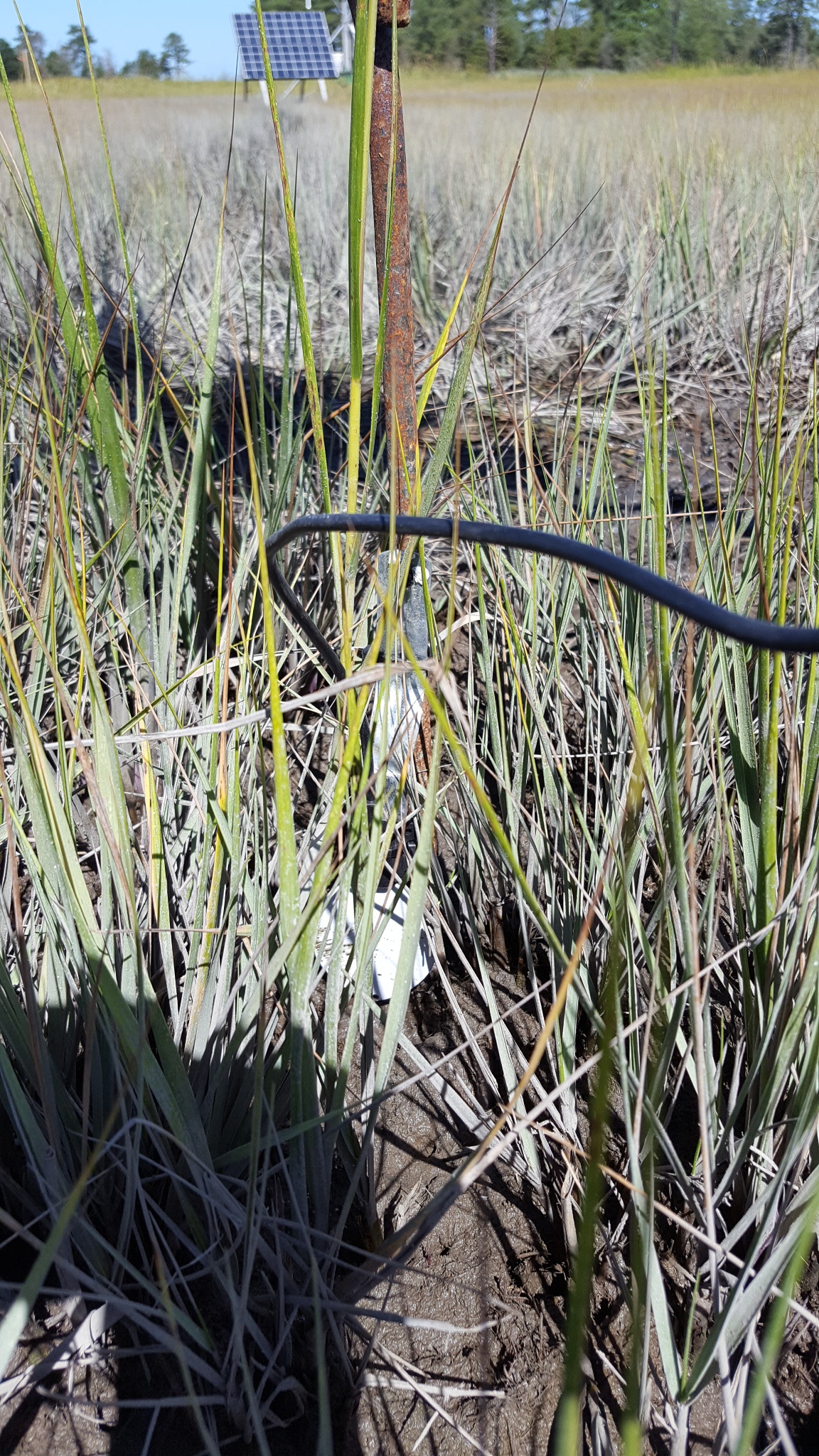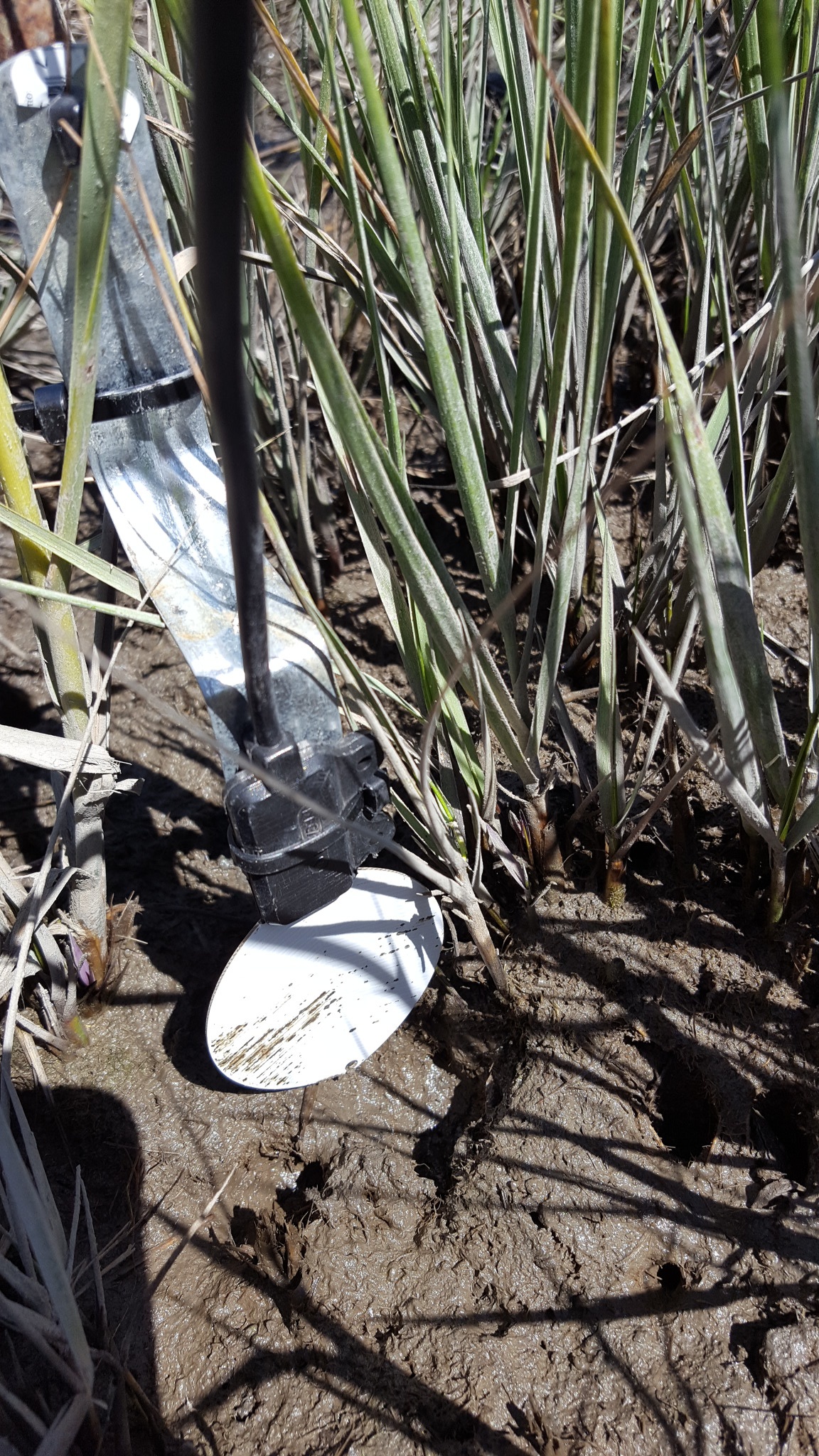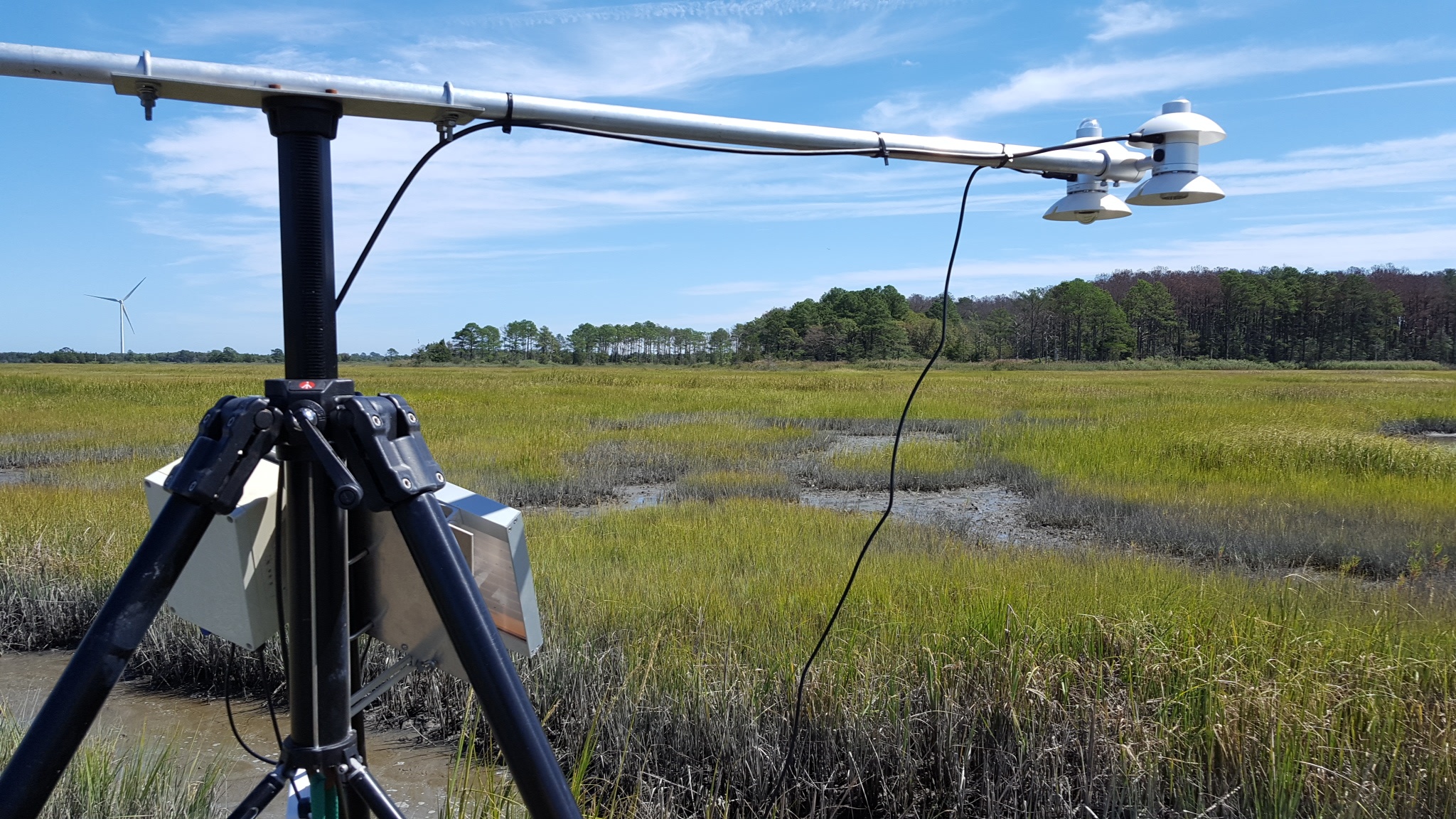9/17/16
Summary: Mostly sunny with very light winds out of the SW
All stations look good this morning
Actions past 24 hours:
- Replace TRH probe at site 13
- measured NR01 height and fixed Tsoil at site 9
- Gary did some more work on data issues
To dos:
- Take Terry on a boat ride to the Marsh
Sensor Status:
T/RH: ok
P: ok
2D Gill: ok
csat u,v: ok
csat ldiag: ok
csat w, tc: ok
EC150: ok
motes: ok
Wetness: ok
radiation: ok
Tsoil: ok
Gsoil: ok
Qsoil: ok
Cvsoil: not responding
Vbatt: ok
It has been pretty obvious from the plots that the sonic diagnostic flag is worse during the time periods when the data are being "rsync"d back to Boulder. This is only for the CSAT3, not the CSAT3A/EC150. When I plot the high-rate data, I even find data gaps – 12s for one period I looked at. Even during non-rsync times, there are continuous non-zero ldiag values. These should be pretty close to zero all the time.
I suspect that the CSAT3s are picking up RF interference from the cell phones. If it hasn't been done already, we should play with grounding the heads and boxes (after checking to see if the mechanical connections already do this). Andy knows the drill all too well.
If this persists, it isn't a huge problem, since bad samples should be rejected by software, but it would be nice to fix if we can.
We left about 10:30 this morning to go into the Marsh. We had to go the long way but that was good since it
was Andy's first trip. We visited 2 sites. Site 13 to replace a bad TRH probe and site 9 to measure the
height of the NR01 and to replace the Tsoil PIC. Due to some complications (see below) we went out again
in the afternoon.
Results:
Site 13 - The TRH probe appears fine. The problem was the SHT75 transducer. There was a fair amount of
corrosion on the transducer. TRH61 was replaced with TRH11.
Site 9 - The height of the NR01 is 166 cm. We were going to replace the Tsoil PIC but I had forgotten to change
its calibration coefficients to match the probe in the ground. So we decided to go back to the base to have
lunch then deal with the PIC.
After lunch I discovered that the original PIC, #04, had its coefficients all set to zero. This explains why the
response from the sensor was -0.01 for all temperature levels. I was able to restore the coefficients. Andy
and I then went back out to install TS04 PIC board. Everything worked as expected. It is a mystery to me about
the coefficients getting set to all zeros.
9/16/16
Summary: Partly cloudy with light winds out of the NE.
TRH down at site 13. Tower data from Emerald channels down (refer to blog post for details)
Actions past 24 hours:
- Tower Emerald down last night, Gary got it going this morning
To dos:
- visit site 13 for TRH issue
- visit site 9 to measure radiometer height and replace Tsoil PIC
Sensor Status:
T/RH: ok, except for site 13
P: ok
2D Gill: ok
csat u,v: ok
csat ldiag: ok
csat w, tc: ok
EC150: ok
motes: ok
Wetness: ok
radiation: ok
Tsoil: ok, bad at mote #1 (site 9)
Gsoil: ok
Qsoil: ok
Cvsoil: not responding
Vbatt: ok
Last night Steve O. caught that the tower DSM had stopped writing to the USB disk because it had filled up. I turned on --remove-source-files in the rsyncs from barolo, so that has cleaned off the disk and should prevent it from filling up again. The rsync script leaves the most recent 7 days of data files on the local disk.
In restarting the DSM process last night, the emerald card did not come back, and so we lost winds and TRH above 10m from around 2016-09-16 23:30 to 2016-09-17 13:30 UTC. This issue with the emerald cards is being tracked in a JIRA issue: ISFS-127. I got things working again this morning by rebooting the dsm.
9/15/16
Summary: Cloudy with winds between 5 and 10 m/s out of the NE.
TRH down at site 13. Sensor is responding but bad data from transducer.
Actions past 24 hours:
- Installed Mote #1 and rad/soil sensors at site 9
- cleaned all radiometers
To dos:
- depending on weather, visit site 13 for TRH issue
Sensor Status:
T/RH: ok, except for site 13. Sensor went down arounf 20:30 yesterday
P: ok
2D Gill: ok
csat u,v: ok
csat ldiag: ok
csat w, tc: ok
EC150: ok
motes: ok
Wetness: ok
radiation: ok
Tsoil: ok, bad at mote #1 (site 9)
Gsoil: ok
Qsoil: ok
Cvsoil: not responding
Vbatt: ok
Gary and I went to the Marsh today to move Mote #1 from site 15 to site 9. At 15 the TP01 PIC board
was removed since the sensor is not working correctly. It will be taken back to Boulder for for repairs.
The NR01 domes were cleaned.
At site 9 the cleaned NR01 along with the soil probes were installed. The mote was connected to port 7.
At the site the tsoil was not coming in. The PIC board may be bad so Andy will bring out a few spares.
We also went to site 1 to clean the NR01 domes.
Gary will make the necessary mods to the config for port 7 at site 9.
Soil sensors at 9
HFT - 103638
Qsoil - 14
Tsoil - 4
9/14/16
Summary: Light winds, < 5 m/s, out of the WSW, clear,
Worked on new DSM to test questionable GILL 2D cable. To verify
DSM was setup correctly built a test cable for the GILL. Test cable
verified DSM was setup correctly so 2D cable is bad. Will take back to Boulder
Actions past 24 hours:
- Base work, no boating yesterday
- build test cable to check GILL 2D and DSM settings
To dos:
- move Mote #1 and NR01 to site 9
- add soil probes to Mote #1
Sensor Status:
T/RH: ok
P: ok
2D Gill: ok
csat u,v: ok
csat ldiag: ok
csat w, tc: ok
EC150: ok
motes: ok, mote #1 does not have soil probes
Wetness: ok
radiation: ok
Tsoil: ok
Gsoil: ok
Qsoil: ok
Cvsoil: not responding
Vbatt: ok
Just put more error-checking in vertex.tilt.plot(). Not sure why it was necessary...
Also note my <new> format, with 2 summary plots at the top. These will break with a webplots_redo, but I'll deal with that some time in the future.
9/13/16
Summary: Light winds, < 5 m/s, out of the SSE, clear,
Actions past 24 hours:
- Moved Mote #3 from site 15 to site 1
- Installed soil sensors (Tsoil, Gsoil, Qsoil) at site 1 along with NR01
- Moved wetness sensor at Mote #2 to a vertical position near the soil surface
To dos:
- may move Mote #1 and NR01 to site 9
Sensor Status:
T/RH: ok
P: ok
2D Gill: ok
csat u,v: ok
csat ldiag: ok
csat w, tc: ok
EC150: ok
motes: ok, mote #1 does not have soil probes
Wetness: ok
radiation: ok
Tsoil: ok
Gsoil: ok
Qsoil: ok
Cvsoil: not responding
Vbatt: ok
~ 12:00 Dr. Oncley wanted a wetness sensor put down at the surface of the soil in a vertical position.
So we moved mote #2 Wetness to this new position, photo 1 & 2. Since 15 seems to flood all the time
so we should see some action on this probe.
One concern is the cable from the probe to the NR01 was short. Photo 3 shows
the cable going back to the NR01. The downlooking sensors may see it.
We left the marina around 11am while the tide was still going out.
We visited S15 and removed M3 (ID4), then took that tripod and the NR01 to S1 to install them. I think the idea is that the radiation/soil sensors will be deployed along a line from the turbine to S15.
The radiation boom is aimed south, 175 cm from ground to center of NR01. Steve buried the soil probes (T, Q, G). S1 seemed like a much drier site than many others, perhaps because it's a 130m hike from the water.
We removed the solar panel and battery from the tripod since they are not needed, this mote is connected directly to port 7 on the DSM. I verified that we saw data messages for all the sensors from mote, but I have not yet changed the NIDAS config.
We arrived back at the marina around 2:45.
For whatever it's worth, yesterday when we returned from S8, I measured the clearance between the bottom of the bridge and the motor. As long as all the passengers can duck lower than the motor, the motor is the limiting factor for clearing the bridge. The clearance was 16", and at the time the Lewes station tide level reported 2.26 ft above MLLW. So I hope that gives a guide as to when the bridge is passable or not. For example, if the Lewes station is measuring 3.25 ft above MLLW, something that is updated every 6 minutes and can be checked from a smart phone while out on the marsh, then that would leave 4 inches of clearance under the bridge. I'm not suggesting what a safe clearance should be, only wondering if this can help with planning.
Kurt's guidance is to look for the "step" in the bridge foundation at either side of the bridge: If it's visible then there is enough clearance. That has been a good rule of thumb for us that we have followed. However, maybe there's still enough clearance even when the step is not quite visible, meaning we could save ourselves the 30 minutes coming back the long way.
9/12/16
Summary: Light winds, 5 m/s, out of the NE, clear,
EC150, at site #15, was down for a period yesterday (refer to blog for more information)
Actions past 24 hours:
- installed Gill 2D at site 8
- EC150 was down for short period, Oncley got it back up
To dos:
- move rad/soil Mote #1 to another site, #1 or #9
Sensor Status:
T/RH: ok
P: ok
2D Gill: ok
csat u,v: ok
csat ldiag: ok
csat w, tc: ok
EC150: ok, was down for a period of time yesterday (~11:00 am to ~10:00:pm)
motes: ok
Wetness: ok
radiation: ok
Tsoil: ok
Gsoil: ok
Qsoil: dk
Cvsoil: not responding
Vbatt: ok
This morning, S15's EC150 stopped reporting. It appears to be associated with a ddn/dup at 1451 UTC. (There are several data files around this time. Data are in the file starting 1438 and not in the file starting 1451.) I've just tried eio 5 0/1 and failed to revive it. It also doesn't respond to <cr> to get a prompt. However, the station's Iload was constant during this period (and similar to the day before), which makes you think that the sensor is still trying to function.
FIXED: Somehow emode on 5 was back to 232 (even though it <should> have been set by the script pre_dsm.sh). I just manually entered: emode 5 422 and data started flowing.




